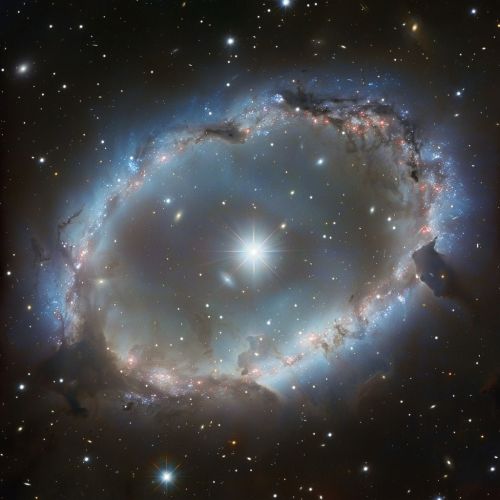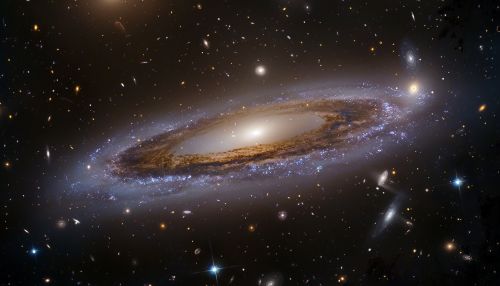Einstein Ring
Introduction
An **Einstein Ring** is a specific type of gravitational lensing phenomenon that occurs when light from a distant source, such as a galaxy or a star, is bent around a massive object, like another galaxy or a black hole, that lies between the source and the observer. This bending of light causes the distant source to appear as a ring-like structure around the massive object. The phenomenon is named after Albert Einstein, whose theory of general relativity predicted the bending of light by gravity.
Formation of Einstein Rings
The formation of an Einstein Ring requires a precise alignment of the source, the lens, and the observer. When these three are perfectly aligned, the light from the source is bent symmetrically around the lens, creating a ring-like appearance. The radius of the ring, known as the Einstein radius, depends on the mass of the lensing object and the distances between the source, the lens, and the observer.
The mathematical description of the Einstein radius (\( \theta_E \)) is given by:
\[ \theta_E = \sqrt{\frac{4GM}{c^2} \frac{D_{ls}}{D_l D_s}} \]
where: - \( G \) is the gravitational constant, - \( M \) is the mass of the lensing object, - \( c \) is the speed of light, - \( D_{ls} \) is the distance between the lens and the source, - \( D_l \) is the distance between the observer and the lens, - \( D_s \) is the distance between the observer and the source.
Types of Einstein Rings
Einstein Rings can be classified based on the nature of the lensing object and the source:
Strong Lensing
In strong lensing, the gravitational field of the lensing object is strong enough to produce multiple images of the source, arcs, or even complete rings. These rings are often referred to as "full" Einstein Rings. Strong lensing is typically observed in cases where the lensing object is a massive galaxy or a galaxy cluster.
Weak Lensing
Weak lensing occurs when the gravitational field of the lensing object is not strong enough to produce distinct multiple images. Instead, it causes slight distortions in the shape of the background source. Weak lensing is more common and can be used to study the distribution of dark matter in the universe.
Microlensing
Microlensing involves smaller lensing objects, such as individual stars or planets. In microlensing events, the source does not form a complete ring but rather experiences a temporary increase in brightness as the lensing object passes in front of it. Microlensing is a valuable tool for detecting exoplanets and studying the structure of the Milky Way.
Observational Techniques
Observing Einstein Rings requires precise astronomical instruments and techniques. Some of the key methods include:
Optical and Infrared Telescopes
High-resolution optical and infrared telescopes, such as the Hubble Space Telescope, are essential for capturing detailed images of Einstein Rings. These telescopes can resolve the fine structures of the rings and provide valuable data for studying the lensing objects and the sources.
Radio Telescopes
Radio telescopes, like the Very Large Array (VLA), are also used to observe Einstein Rings, particularly those formed by radio sources such as quasars. Radio observations can penetrate dust and gas that may obscure optical observations, providing a clearer view of the lensing phenomena.
Gravitational Wave Detectors
Gravitational wave detectors, such as LIGO and Virgo, have the potential to detect gravitational lensing effects in the signals from distant astrophysical events. While this field is still in its infancy, future advancements may allow for the study of Einstein Rings through gravitational wave observations.
Scientific Implications
Einstein Rings provide a wealth of information about the universe. Some of the key scientific implications include:
Mass Distribution
By analyzing the shape and size of Einstein Rings, astronomers can infer the mass distribution of the lensing objects. This information is crucial for understanding the structure and composition of galaxies and galaxy clusters.
Dark Matter
Einstein Rings are powerful tools for studying dark matter, an invisible form of matter that does not emit or absorb light. The gravitational effects of dark matter can be inferred from the lensing patterns, providing insights into its distribution and properties.
Cosmology
Einstein Rings can be used to measure cosmological parameters, such as the Hubble constant, which describes the rate of expansion of the universe. By studying the time delays between multiple images of the same source, astronomers can refine their estimates of these parameters.
Notable Examples
Several notable Einstein Rings have been observed and studied in detail:
The Cosmic Horseshoe
The Cosmic Horseshoe is a striking example of an Einstein Ring formed by a distant galaxy lensed by a massive foreground galaxy. The ring has a nearly perfect circular shape, making it an ideal case for studying gravitational lensing.


SDP.81
SDP.81 is an Einstein Ring discovered by the Atacama Large Millimeter/submillimeter Array (ALMA). The ring is formed by a distant galaxy lensed by a foreground galaxy, and its detailed structure has provided valuable data on star formation and the interstellar medium.
B1608+656
B1608+656 is a quadruply lensed quasar that forms an Einstein Ring. The system has been extensively studied to measure time delays between the multiple images, providing constraints on the Hubble constant and the distribution of dark matter.
See Also
- Gravitational Lensing
- General Relativity
- Dark Matter
- Quasar
- Hubble Space Telescope
- Atacama Large Millimeter/submillimeter Array
